Economics for Business: Government Policies for Economic Management
VerifiedAdded on 2020/02/14
|14
|4493
|124
Report
AI Summary
This report provides an overview of key economic concepts relevant to businesses. It begins by examining supply-side policies, detailing how governments can use them to stimulate economic growth, including tax incentives, labor market reforms, and deregulation. The report then shifts focus to fiscal and monetary policies, explaining how governments utilize these tools to manage economic performance, including strategies for slowing down economies. It explores the relationship between government spending, taxation, interest rates, and their impact on various economic indicators. The report further discusses the advantages and disadvantages of these policies, providing examples from the UK government and concluding with an analysis of their effectiveness in achieving economic objectives. The report also includes tables and figures to support the analysis.
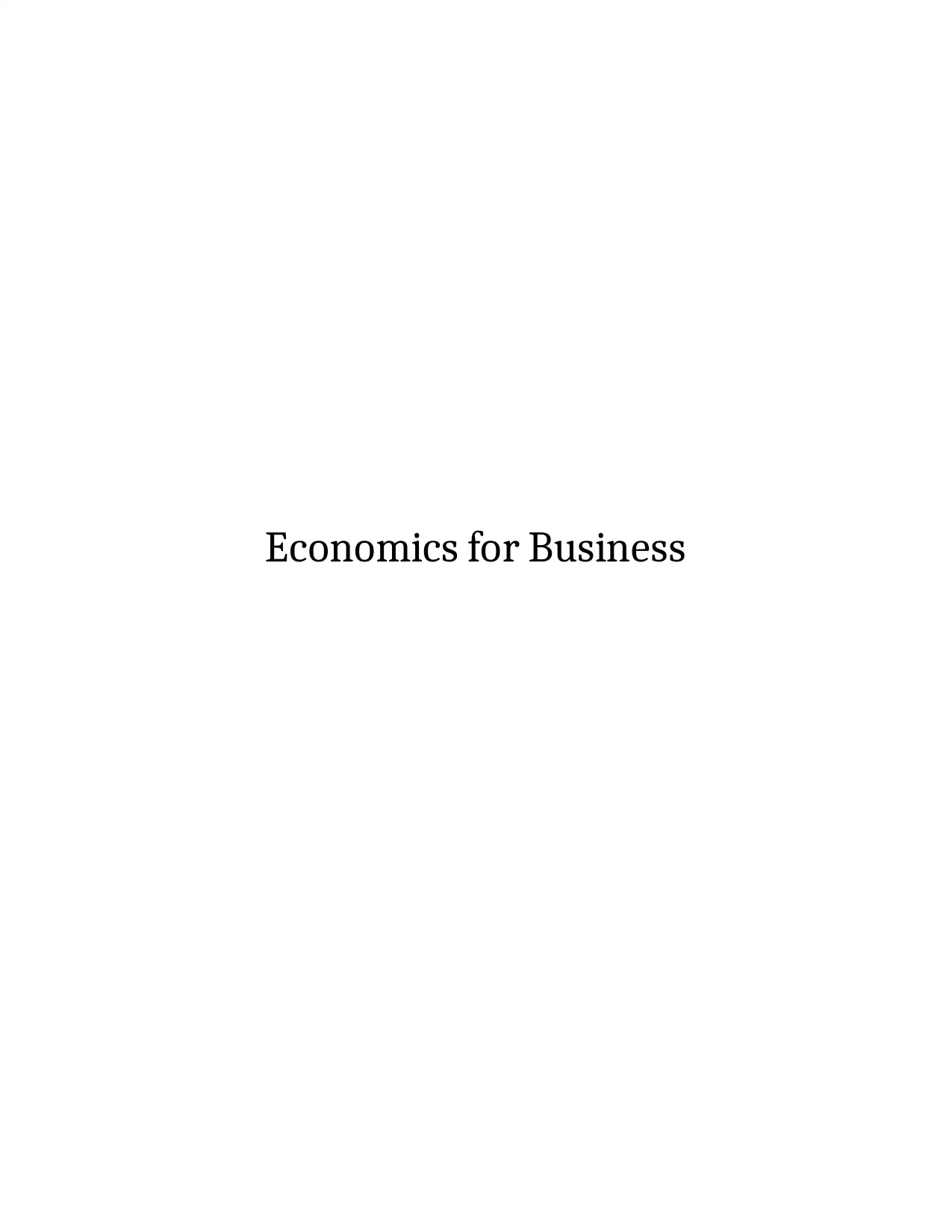
Economics for Business
Paraphrase This Document
Need a fresh take? Get an instant paraphrase of this document with our AI Paraphraser
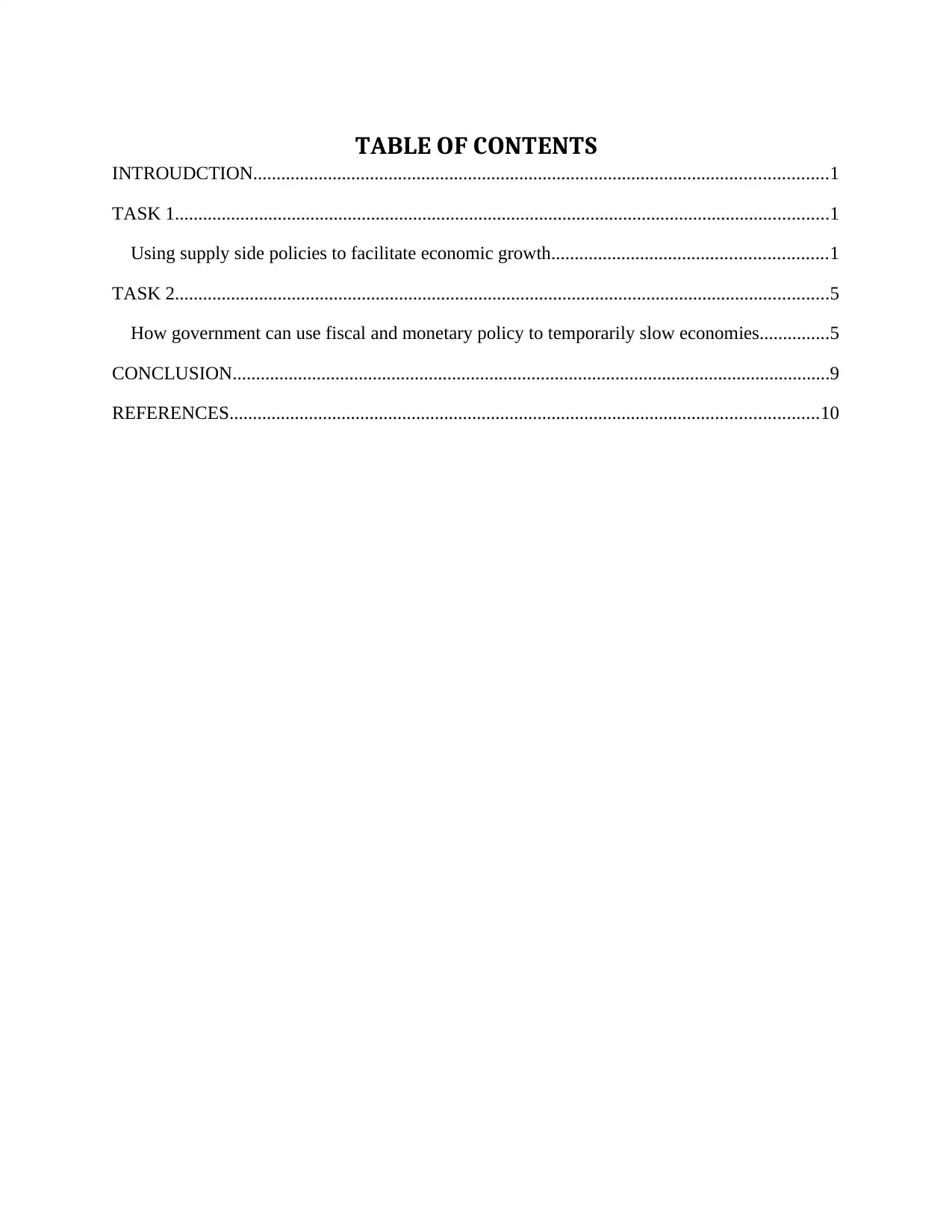
TABLE OF CONTENTS
INTROUDCTION...........................................................................................................................1
TASK 1............................................................................................................................................1
Using supply side policies to facilitate economic growth...........................................................1
TASK 2............................................................................................................................................5
How government can use fiscal and monetary policy to temporarily slow economies...............5
CONCLUSION................................................................................................................................9
REFERENCES..............................................................................................................................10
INTROUDCTION...........................................................................................................................1
TASK 1............................................................................................................................................1
Using supply side policies to facilitate economic growth...........................................................1
TASK 2............................................................................................................................................5
How government can use fiscal and monetary policy to temporarily slow economies...............5
CONCLUSION................................................................................................................................9
REFERENCES..............................................................................................................................10
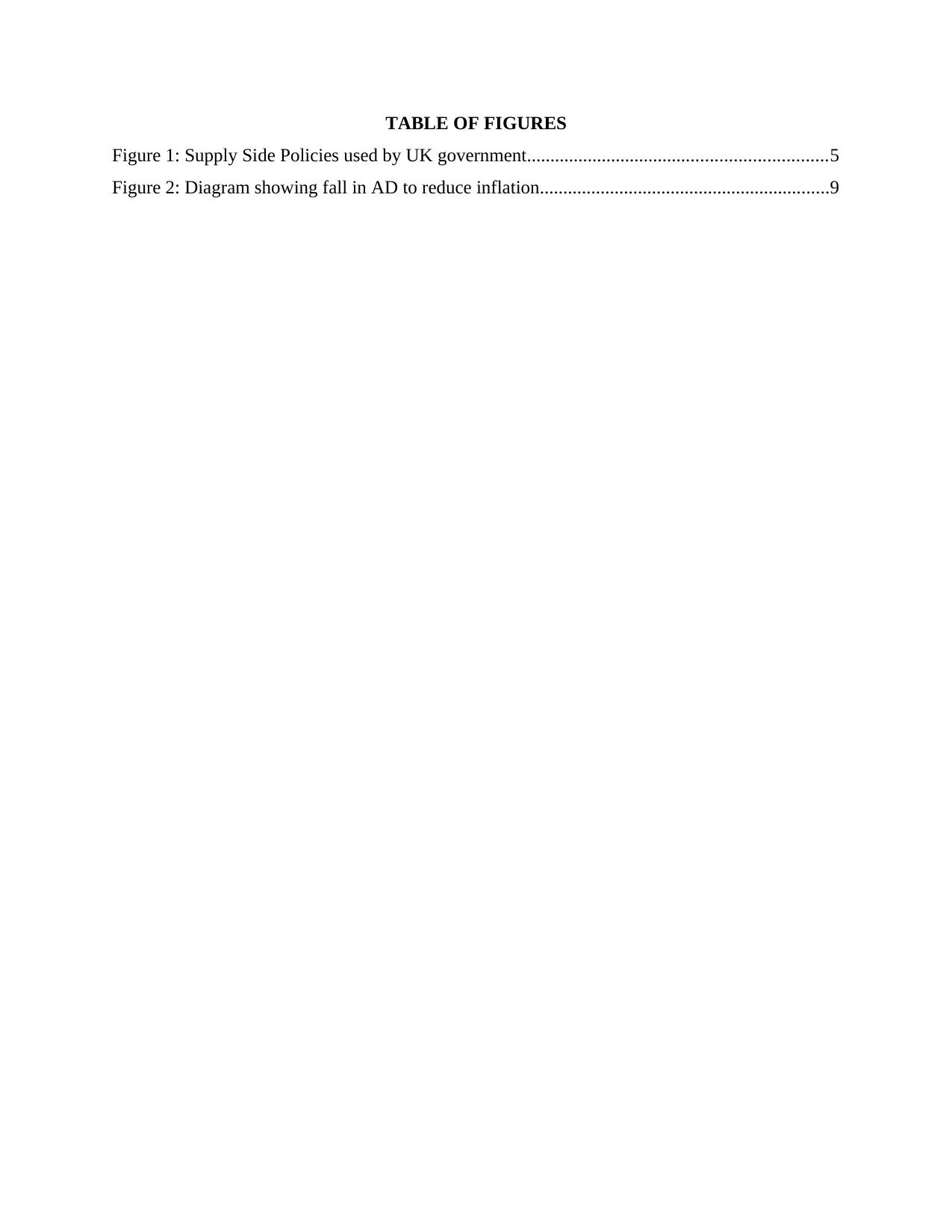
TABLE OF FIGURES
Figure 1: Supply Side Policies used by UK government................................................................5
Figure 2: Diagram showing fall in AD to reduce inflation..............................................................9
Figure 1: Supply Side Policies used by UK government................................................................5
Figure 2: Diagram showing fall in AD to reduce inflation..............................................................9
⊘ This is a preview!⊘
Do you want full access?
Subscribe today to unlock all pages.

Trusted by 1+ million students worldwide
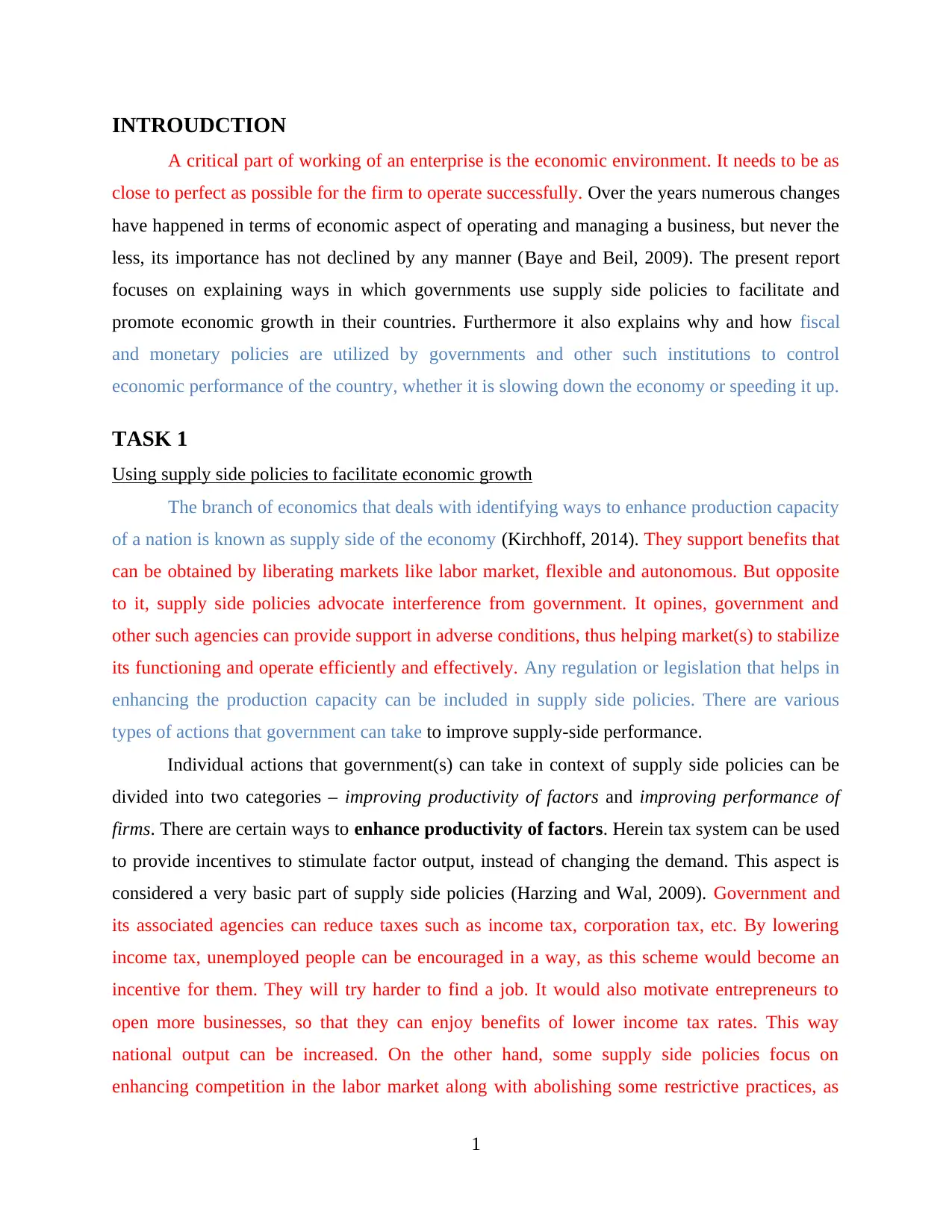
INTROUDCTION
A critical part of working of an enterprise is the economic environment. It needs to be as
close to perfect as possible for the firm to operate successfully. Over the years numerous changes
have happened in terms of economic aspect of operating and managing a business, but never the
less, its importance has not declined by any manner (Baye and Beil, 2009). The present report
focuses on explaining ways in which governments use supply side policies to facilitate and
promote economic growth in their countries. Furthermore it also explains why and how fiscal
and monetary policies are utilized by governments and other such institutions to control
economic performance of the country, whether it is slowing down the economy or speeding it up.
TASK 1
Using supply side policies to facilitate economic growth
The branch of economics that deals with identifying ways to enhance production capacity
of a nation is known as supply side of the economy (Kirchhoff, 2014). They support benefits that
can be obtained by liberating markets like labor market, flexible and autonomous. But opposite
to it, supply side policies advocate interference from government. It opines, government and
other such agencies can provide support in adverse conditions, thus helping market(s) to stabilize
its functioning and operate efficiently and effectively. Any regulation or legislation that helps in
enhancing the production capacity can be included in supply side policies. There are various
types of actions that government can take to improve supply-side performance.
Individual actions that government(s) can take in context of supply side policies can be
divided into two categories – improving productivity of factors and improving performance of
firms. There are certain ways to enhance productivity of factors. Herein tax system can be used
to provide incentives to stimulate factor output, instead of changing the demand. This aspect is
considered a very basic part of supply side policies (Harzing and Wal, 2009). Government and
its associated agencies can reduce taxes such as income tax, corporation tax, etc. By lowering
income tax, unemployed people can be encouraged in a way, as this scheme would become an
incentive for them. They will try harder to find a job. It would also motivate entrepreneurs to
open more businesses, so that they can enjoy benefits of lower income tax rates. This way
national output can be increased. On the other hand, some supply side policies focus on
enhancing competition in the labor market along with abolishing some restrictive practices, as
1
A critical part of working of an enterprise is the economic environment. It needs to be as
close to perfect as possible for the firm to operate successfully. Over the years numerous changes
have happened in terms of economic aspect of operating and managing a business, but never the
less, its importance has not declined by any manner (Baye and Beil, 2009). The present report
focuses on explaining ways in which governments use supply side policies to facilitate and
promote economic growth in their countries. Furthermore it also explains why and how fiscal
and monetary policies are utilized by governments and other such institutions to control
economic performance of the country, whether it is slowing down the economy or speeding it up.
TASK 1
Using supply side policies to facilitate economic growth
The branch of economics that deals with identifying ways to enhance production capacity
of a nation is known as supply side of the economy (Kirchhoff, 2014). They support benefits that
can be obtained by liberating markets like labor market, flexible and autonomous. But opposite
to it, supply side policies advocate interference from government. It opines, government and
other such agencies can provide support in adverse conditions, thus helping market(s) to stabilize
its functioning and operate efficiently and effectively. Any regulation or legislation that helps in
enhancing the production capacity can be included in supply side policies. There are various
types of actions that government can take to improve supply-side performance.
Individual actions that government(s) can take in context of supply side policies can be
divided into two categories – improving productivity of factors and improving performance of
firms. There are certain ways to enhance productivity of factors. Herein tax system can be used
to provide incentives to stimulate factor output, instead of changing the demand. This aspect is
considered a very basic part of supply side policies (Harzing and Wal, 2009). Government and
its associated agencies can reduce taxes such as income tax, corporation tax, etc. By lowering
income tax, unemployed people can be encouraged in a way, as this scheme would become an
incentive for them. They will try harder to find a job. It would also motivate entrepreneurs to
open more businesses, so that they can enjoy benefits of lower income tax rates. This way
national output can be increased. On the other hand, some supply side policies focus on
enhancing competition in the labor market along with abolishing some restrictive practices, as
1
Paraphrase This Document
Need a fresh take? Get an instant paraphrase of this document with our AI Paraphraser
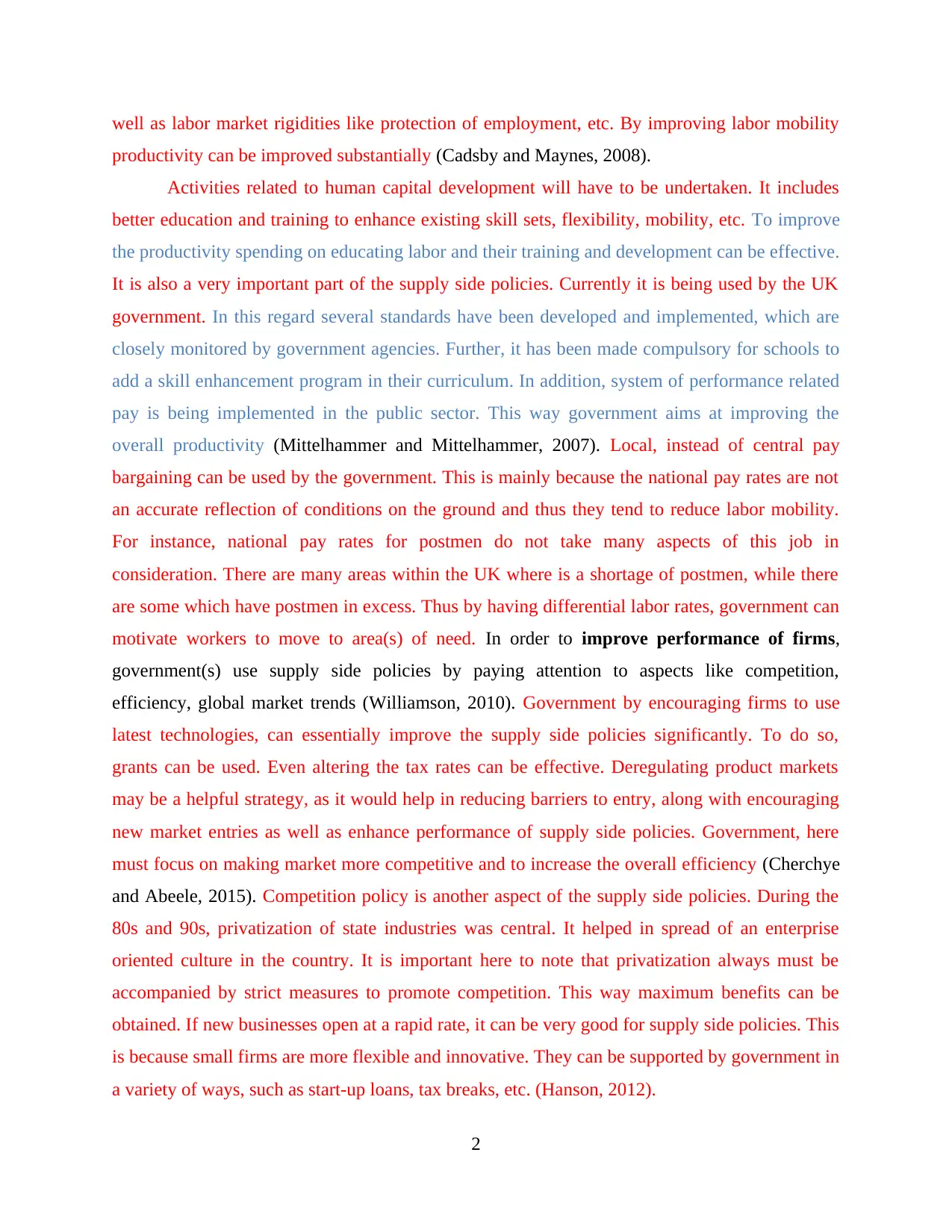
well as labor market rigidities like protection of employment, etc. By improving labor mobility
productivity can be improved substantially (Cadsby and Maynes, 2008).
Activities related to human capital development will have to be undertaken. It includes
better education and training to enhance existing skill sets, flexibility, mobility, etc. To improve
the productivity spending on educating labor and their training and development can be effective.
It is also a very important part of the supply side policies. Currently it is being used by the UK
government. In this regard several standards have been developed and implemented, which are
closely monitored by government agencies. Further, it has been made compulsory for schools to
add a skill enhancement program in their curriculum. In addition, system of performance related
pay is being implemented in the public sector. This way government aims at improving the
overall productivity (Mittelhammer and Mittelhammer, 2007). Local, instead of central pay
bargaining can be used by the government. This is mainly because the national pay rates are not
an accurate reflection of conditions on the ground and thus they tend to reduce labor mobility.
For instance, national pay rates for postmen do not take many aspects of this job in
consideration. There are many areas within the UK where is a shortage of postmen, while there
are some which have postmen in excess. Thus by having differential labor rates, government can
motivate workers to move to area(s) of need. In order to improve performance of firms,
government(s) use supply side policies by paying attention to aspects like competition,
efficiency, global market trends (Williamson, 2010). Government by encouraging firms to use
latest technologies, can essentially improve the supply side policies significantly. To do so,
grants can be used. Even altering the tax rates can be effective. Deregulating product markets
may be a helpful strategy, as it would help in reducing barriers to entry, along with encouraging
new market entries as well as enhance performance of supply side policies. Government, here
must focus on making market more competitive and to increase the overall efficiency (Cherchye
and Abeele, 2015). Competition policy is another aspect of the supply side policies. During the
80s and 90s, privatization of state industries was central. It helped in spread of an enterprise
oriented culture in the country. It is important here to note that privatization always must be
accompanied by strict measures to promote competition. This way maximum benefits can be
obtained. If new businesses open at a rapid rate, it can be very good for supply side policies. This
is because small firms are more flexible and innovative. They can be supported by government in
a variety of ways, such as start-up loans, tax breaks, etc. (Hanson, 2012).
2
productivity can be improved substantially (Cadsby and Maynes, 2008).
Activities related to human capital development will have to be undertaken. It includes
better education and training to enhance existing skill sets, flexibility, mobility, etc. To improve
the productivity spending on educating labor and their training and development can be effective.
It is also a very important part of the supply side policies. Currently it is being used by the UK
government. In this regard several standards have been developed and implemented, which are
closely monitored by government agencies. Further, it has been made compulsory for schools to
add a skill enhancement program in their curriculum. In addition, system of performance related
pay is being implemented in the public sector. This way government aims at improving the
overall productivity (Mittelhammer and Mittelhammer, 2007). Local, instead of central pay
bargaining can be used by the government. This is mainly because the national pay rates are not
an accurate reflection of conditions on the ground and thus they tend to reduce labor mobility.
For instance, national pay rates for postmen do not take many aspects of this job in
consideration. There are many areas within the UK where is a shortage of postmen, while there
are some which have postmen in excess. Thus by having differential labor rates, government can
motivate workers to move to area(s) of need. In order to improve performance of firms,
government(s) use supply side policies by paying attention to aspects like competition,
efficiency, global market trends (Williamson, 2010). Government by encouraging firms to use
latest technologies, can essentially improve the supply side policies significantly. To do so,
grants can be used. Even altering the tax rates can be effective. Deregulating product markets
may be a helpful strategy, as it would help in reducing barriers to entry, along with encouraging
new market entries as well as enhance performance of supply side policies. Government, here
must focus on making market more competitive and to increase the overall efficiency (Cherchye
and Abeele, 2015). Competition policy is another aspect of the supply side policies. During the
80s and 90s, privatization of state industries was central. It helped in spread of an enterprise
oriented culture in the country. It is important here to note that privatization always must be
accompanied by strict measures to promote competition. This way maximum benefits can be
obtained. If new businesses open at a rapid rate, it can be very good for supply side policies. This
is because small firms are more flexible and innovative. They can be supported by government in
a variety of ways, such as start-up loans, tax breaks, etc. (Hanson, 2012).
2
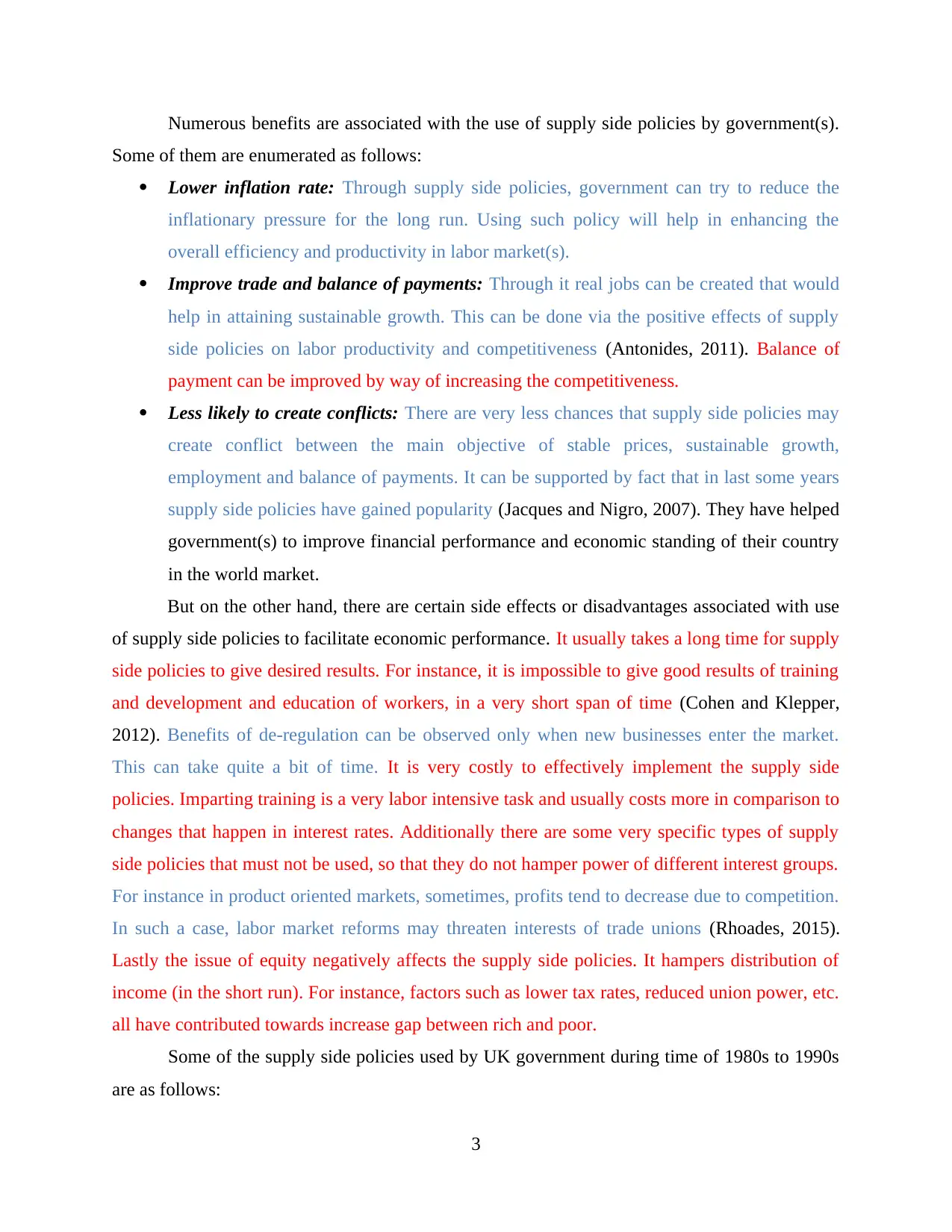
Numerous benefits are associated with the use of supply side policies by government(s).
Some of them are enumerated as follows:
Lower inflation rate: Through supply side policies, government can try to reduce the
inflationary pressure for the long run. Using such policy will help in enhancing the
overall efficiency and productivity in labor market(s).
Improve trade and balance of payments: Through it real jobs can be created that would
help in attaining sustainable growth. This can be done via the positive effects of supply
side policies on labor productivity and competitiveness (Antonides, 2011). Balance of
payment can be improved by way of increasing the competitiveness.
Less likely to create conflicts: There are very less chances that supply side policies may
create conflict between the main objective of stable prices, sustainable growth,
employment and balance of payments. It can be supported by fact that in last some years
supply side policies have gained popularity (Jacques and Nigro, 2007). They have helped
government(s) to improve financial performance and economic standing of their country
in the world market.
But on the other hand, there are certain side effects or disadvantages associated with use
of supply side policies to facilitate economic performance. It usually takes a long time for supply
side policies to give desired results. For instance, it is impossible to give good results of training
and development and education of workers, in a very short span of time (Cohen and Klepper,
2012). Benefits of de-regulation can be observed only when new businesses enter the market.
This can take quite a bit of time. It is very costly to effectively implement the supply side
policies. Imparting training is a very labor intensive task and usually costs more in comparison to
changes that happen in interest rates. Additionally there are some very specific types of supply
side policies that must not be used, so that they do not hamper power of different interest groups.
For instance in product oriented markets, sometimes, profits tend to decrease due to competition.
In such a case, labor market reforms may threaten interests of trade unions (Rhoades, 2015).
Lastly the issue of equity negatively affects the supply side policies. It hampers distribution of
income (in the short run). For instance, factors such as lower tax rates, reduced union power, etc.
all have contributed towards increase gap between rich and poor.
Some of the supply side policies used by UK government during time of 1980s to 1990s
are as follows:
3
Some of them are enumerated as follows:
Lower inflation rate: Through supply side policies, government can try to reduce the
inflationary pressure for the long run. Using such policy will help in enhancing the
overall efficiency and productivity in labor market(s).
Improve trade and balance of payments: Through it real jobs can be created that would
help in attaining sustainable growth. This can be done via the positive effects of supply
side policies on labor productivity and competitiveness (Antonides, 2011). Balance of
payment can be improved by way of increasing the competitiveness.
Less likely to create conflicts: There are very less chances that supply side policies may
create conflict between the main objective of stable prices, sustainable growth,
employment and balance of payments. It can be supported by fact that in last some years
supply side policies have gained popularity (Jacques and Nigro, 2007). They have helped
government(s) to improve financial performance and economic standing of their country
in the world market.
But on the other hand, there are certain side effects or disadvantages associated with use
of supply side policies to facilitate economic performance. It usually takes a long time for supply
side policies to give desired results. For instance, it is impossible to give good results of training
and development and education of workers, in a very short span of time (Cohen and Klepper,
2012). Benefits of de-regulation can be observed only when new businesses enter the market.
This can take quite a bit of time. It is very costly to effectively implement the supply side
policies. Imparting training is a very labor intensive task and usually costs more in comparison to
changes that happen in interest rates. Additionally there are some very specific types of supply
side policies that must not be used, so that they do not hamper power of different interest groups.
For instance in product oriented markets, sometimes, profits tend to decrease due to competition.
In such a case, labor market reforms may threaten interests of trade unions (Rhoades, 2015).
Lastly the issue of equity negatively affects the supply side policies. It hampers distribution of
income (in the short run). For instance, factors such as lower tax rates, reduced union power, etc.
all have contributed towards increase gap between rich and poor.
Some of the supply side policies used by UK government during time of 1980s to 1990s
are as follows:
3
⊘ This is a preview!⊘
Do you want full access?
Subscribe today to unlock all pages.

Trusted by 1+ million students worldwide
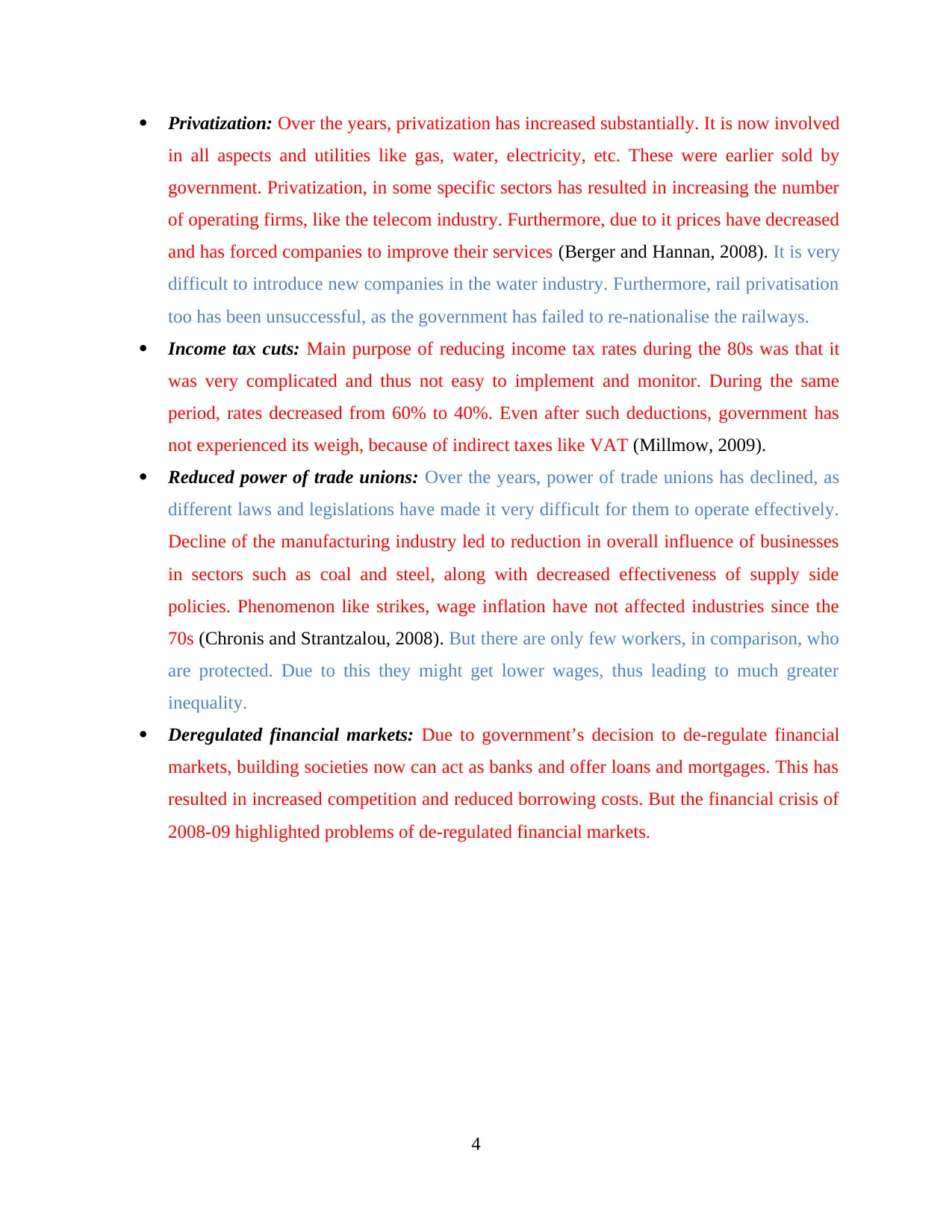
Privatization: Over the years, privatization has increased substantially. It is now involved
in all aspects and utilities like gas, water, electricity, etc. These were earlier sold by
government. Privatization, in some specific sectors has resulted in increasing the number
of operating firms, like the telecom industry. Furthermore, due to it prices have decreased
and has forced companies to improve their services (Berger and Hannan, 2008). It is very
difficult to introduce new companies in the water industry. Furthermore, rail privatisation
too has been unsuccessful, as the government has failed to re-nationalise the railways.
Income tax cuts: Main purpose of reducing income tax rates during the 80s was that it
was very complicated and thus not easy to implement and monitor. During the same
period, rates decreased from 60% to 40%. Even after such deductions, government has
not experienced its weigh, because of indirect taxes like VAT (Millmow, 2009).
Reduced power of trade unions: Over the years, power of trade unions has declined, as
different laws and legislations have made it very difficult for them to operate effectively.
Decline of the manufacturing industry led to reduction in overall influence of businesses
in sectors such as coal and steel, along with decreased effectiveness of supply side
policies. Phenomenon like strikes, wage inflation have not affected industries since the
70s (Chronis and Strantzalou, 2008). But there are only few workers, in comparison, who
are protected. Due to this they might get lower wages, thus leading to much greater
inequality.
Deregulated financial markets: Due to government’s decision to de-regulate financial
markets, building societies now can act as banks and offer loans and mortgages. This has
resulted in increased competition and reduced borrowing costs. But the financial crisis of
2008-09 highlighted problems of de-regulated financial markets.
4
in all aspects and utilities like gas, water, electricity, etc. These were earlier sold by
government. Privatization, in some specific sectors has resulted in increasing the number
of operating firms, like the telecom industry. Furthermore, due to it prices have decreased
and has forced companies to improve their services (Berger and Hannan, 2008). It is very
difficult to introduce new companies in the water industry. Furthermore, rail privatisation
too has been unsuccessful, as the government has failed to re-nationalise the railways.
Income tax cuts: Main purpose of reducing income tax rates during the 80s was that it
was very complicated and thus not easy to implement and monitor. During the same
period, rates decreased from 60% to 40%. Even after such deductions, government has
not experienced its weigh, because of indirect taxes like VAT (Millmow, 2009).
Reduced power of trade unions: Over the years, power of trade unions has declined, as
different laws and legislations have made it very difficult for them to operate effectively.
Decline of the manufacturing industry led to reduction in overall influence of businesses
in sectors such as coal and steel, along with decreased effectiveness of supply side
policies. Phenomenon like strikes, wage inflation have not affected industries since the
70s (Chronis and Strantzalou, 2008). But there are only few workers, in comparison, who
are protected. Due to this they might get lower wages, thus leading to much greater
inequality.
Deregulated financial markets: Due to government’s decision to de-regulate financial
markets, building societies now can act as banks and offer loans and mortgages. This has
resulted in increased competition and reduced borrowing costs. But the financial crisis of
2008-09 highlighted problems of de-regulated financial markets.
4
Paraphrase This Document
Need a fresh take? Get an instant paraphrase of this document with our AI Paraphraser
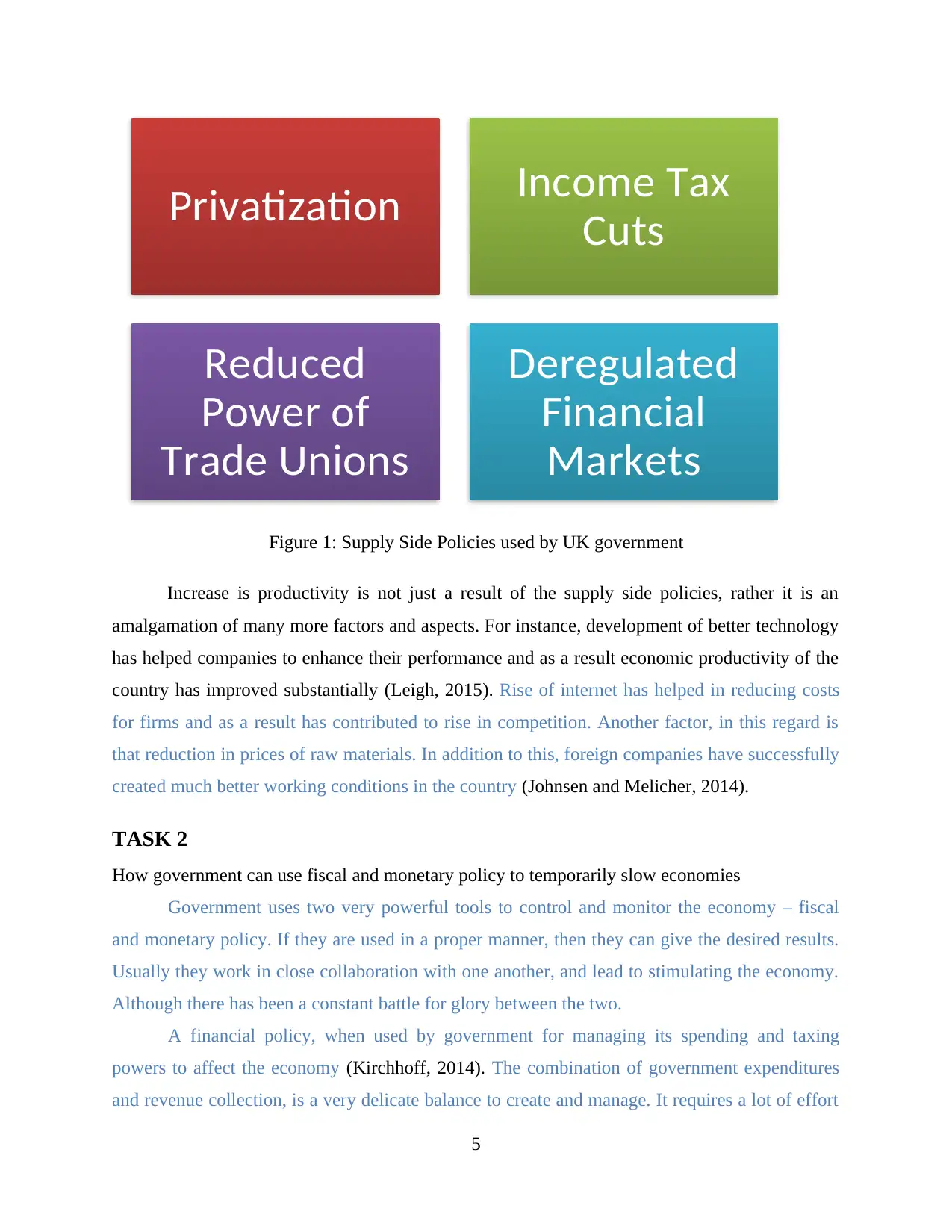
Figure 1: Supply Side Policies used by UK government
Increase is productivity is not just a result of the supply side policies, rather it is an
amalgamation of many more factors and aspects. For instance, development of better technology
has helped companies to enhance their performance and as a result economic productivity of the
country has improved substantially (Leigh, 2015). Rise of internet has helped in reducing costs
for firms and as a result has contributed to rise in competition. Another factor, in this regard is
that reduction in prices of raw materials. In addition to this, foreign companies have successfully
created much better working conditions in the country (Johnsen and Melicher, 2014).
TASK 2
How government can use fiscal and monetary policy to temporarily slow economies
Government uses two very powerful tools to control and monitor the economy – fiscal
and monetary policy. If they are used in a proper manner, then they can give the desired results.
Usually they work in close collaboration with one another, and lead to stimulating the economy.
Although there has been a constant battle for glory between the two.
A financial policy, when used by government for managing its spending and taxing
powers to affect the economy (Kirchhoff, 2014). The combination of government expenditures
and revenue collection, is a very delicate balance to create and manage. It requires a lot of effort
5
Privatization Income Tax
Cuts
Reduced
Power of
Trade Unions
Deregulated
Financial
Markets
Increase is productivity is not just a result of the supply side policies, rather it is an
amalgamation of many more factors and aspects. For instance, development of better technology
has helped companies to enhance their performance and as a result economic productivity of the
country has improved substantially (Leigh, 2015). Rise of internet has helped in reducing costs
for firms and as a result has contributed to rise in competition. Another factor, in this regard is
that reduction in prices of raw materials. In addition to this, foreign companies have successfully
created much better working conditions in the country (Johnsen and Melicher, 2014).
TASK 2
How government can use fiscal and monetary policy to temporarily slow economies
Government uses two very powerful tools to control and monitor the economy – fiscal
and monetary policy. If they are used in a proper manner, then they can give the desired results.
Usually they work in close collaboration with one another, and lead to stimulating the economy.
Although there has been a constant battle for glory between the two.
A financial policy, when used by government for managing its spending and taxing
powers to affect the economy (Kirchhoff, 2014). The combination of government expenditures
and revenue collection, is a very delicate balance to create and manage. It requires a lot of effort
5
Privatization Income Tax
Cuts
Reduced
Power of
Trade Unions
Deregulated
Financial
Markets
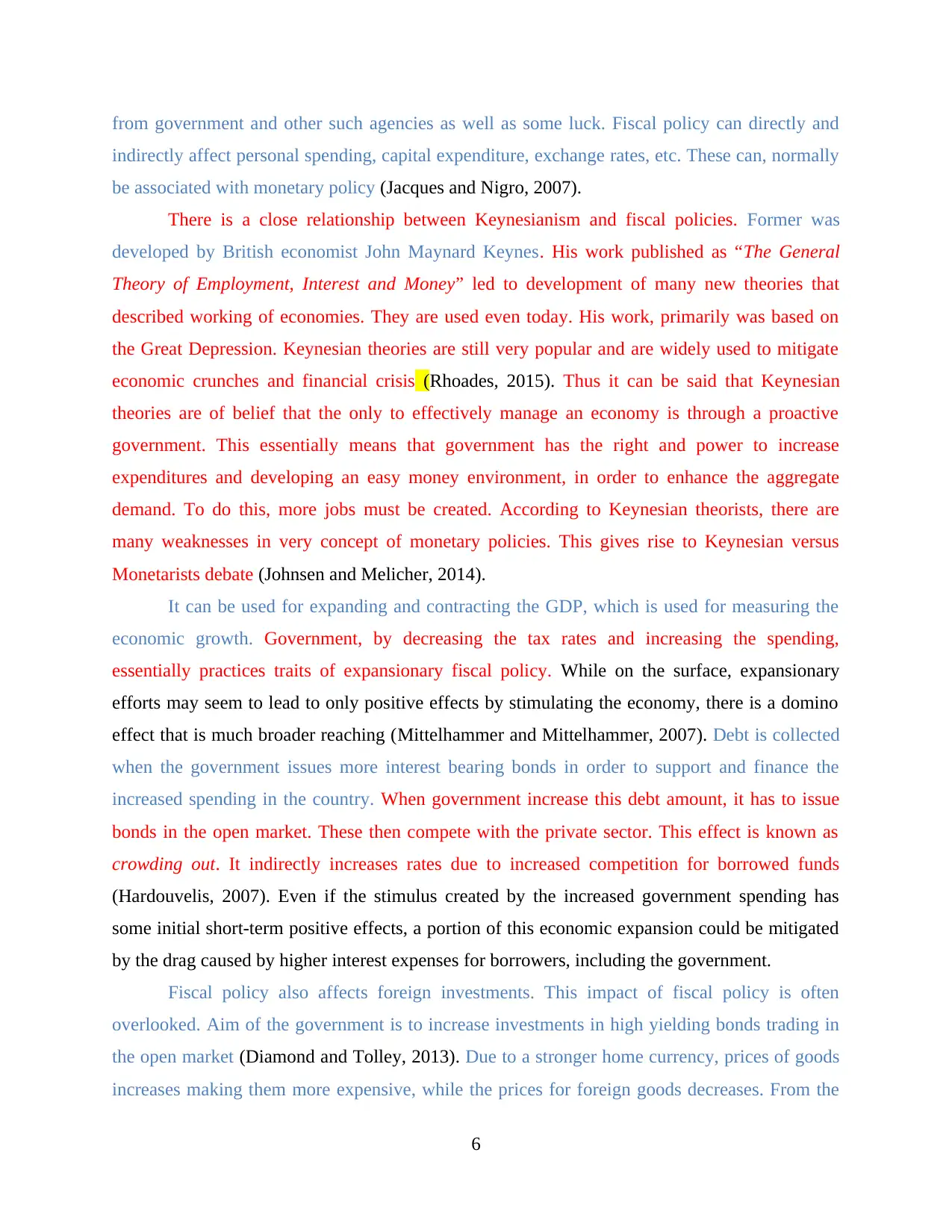
from government and other such agencies as well as some luck. Fiscal policy can directly and
indirectly affect personal spending, capital expenditure, exchange rates, etc. These can, normally
be associated with monetary policy (Jacques and Nigro, 2007).
There is a close relationship between Keynesianism and fiscal policies. Former was
developed by British economist John Maynard Keynes. His work published as “The General
Theory of Employment, Interest and Money” led to development of many new theories that
described working of economies. They are used even today. His work, primarily was based on
the Great Depression. Keynesian theories are still very popular and are widely used to mitigate
economic crunches and financial crisis (Rhoades, 2015). Thus it can be said that Keynesian
theories are of belief that the only to effectively manage an economy is through a proactive
government. This essentially means that government has the right and power to increase
expenditures and developing an easy money environment, in order to enhance the aggregate
demand. To do this, more jobs must be created. According to Keynesian theorists, there are
many weaknesses in very concept of monetary policies. This gives rise to Keynesian versus
Monetarists debate (Johnsen and Melicher, 2014).
It can be used for expanding and contracting the GDP, which is used for measuring the
economic growth. Government, by decreasing the tax rates and increasing the spending,
essentially practices traits of expansionary fiscal policy. While on the surface, expansionary
efforts may seem to lead to only positive effects by stimulating the economy, there is a domino
effect that is much broader reaching (Mittelhammer and Mittelhammer, 2007). Debt is collected
when the government issues more interest bearing bonds in order to support and finance the
increased spending in the country. When government increase this debt amount, it has to issue
bonds in the open market. These then compete with the private sector. This effect is known as
crowding out. It indirectly increases rates due to increased competition for borrowed funds
(Hardouvelis, 2007). Even if the stimulus created by the increased government spending has
some initial short-term positive effects, a portion of this economic expansion could be mitigated
by the drag caused by higher interest expenses for borrowers, including the government.
Fiscal policy also affects foreign investments. This impact of fiscal policy is often
overlooked. Aim of the government is to increase investments in high yielding bonds trading in
the open market (Diamond and Tolley, 2013). Due to a stronger home currency, prices of goods
increases making them more expensive, while the prices for foreign goods decreases. From the
6
indirectly affect personal spending, capital expenditure, exchange rates, etc. These can, normally
be associated with monetary policy (Jacques and Nigro, 2007).
There is a close relationship between Keynesianism and fiscal policies. Former was
developed by British economist John Maynard Keynes. His work published as “The General
Theory of Employment, Interest and Money” led to development of many new theories that
described working of economies. They are used even today. His work, primarily was based on
the Great Depression. Keynesian theories are still very popular and are widely used to mitigate
economic crunches and financial crisis (Rhoades, 2015). Thus it can be said that Keynesian
theories are of belief that the only to effectively manage an economy is through a proactive
government. This essentially means that government has the right and power to increase
expenditures and developing an easy money environment, in order to enhance the aggregate
demand. To do this, more jobs must be created. According to Keynesian theorists, there are
many weaknesses in very concept of monetary policies. This gives rise to Keynesian versus
Monetarists debate (Johnsen and Melicher, 2014).
It can be used for expanding and contracting the GDP, which is used for measuring the
economic growth. Government, by decreasing the tax rates and increasing the spending,
essentially practices traits of expansionary fiscal policy. While on the surface, expansionary
efforts may seem to lead to only positive effects by stimulating the economy, there is a domino
effect that is much broader reaching (Mittelhammer and Mittelhammer, 2007). Debt is collected
when the government issues more interest bearing bonds in order to support and finance the
increased spending in the country. When government increase this debt amount, it has to issue
bonds in the open market. These then compete with the private sector. This effect is known as
crowding out. It indirectly increases rates due to increased competition for borrowed funds
(Hardouvelis, 2007). Even if the stimulus created by the increased government spending has
some initial short-term positive effects, a portion of this economic expansion could be mitigated
by the drag caused by higher interest expenses for borrowers, including the government.
Fiscal policy also affects foreign investments. This impact of fiscal policy is often
overlooked. Aim of the government is to increase investments in high yielding bonds trading in
the open market (Diamond and Tolley, 2013). Due to a stronger home currency, prices of goods
increases making them more expensive, while the prices for foreign goods decreases. From the
6
⊘ This is a preview!⊘
Do you want full access?
Subscribe today to unlock all pages.

Trusted by 1+ million students worldwide
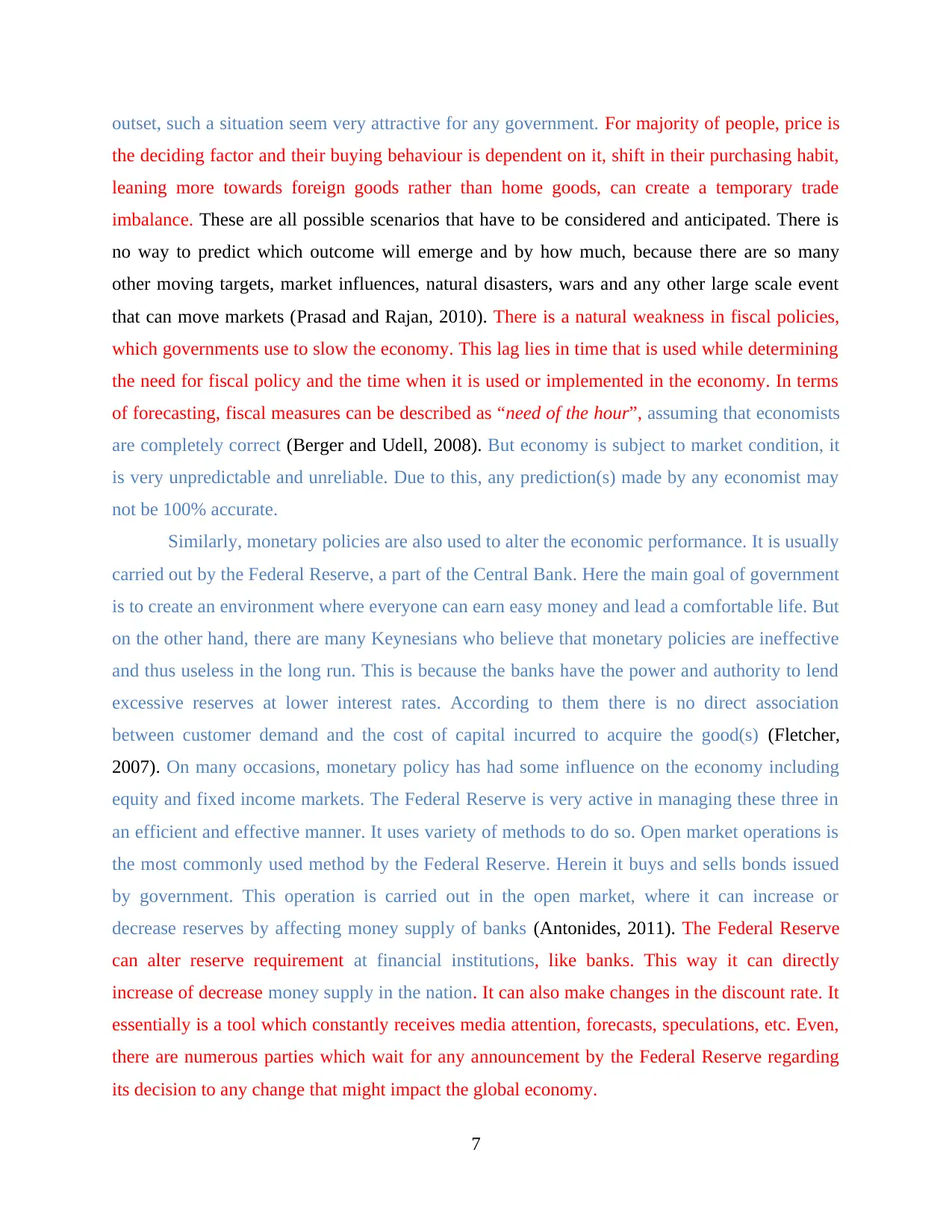
outset, such a situation seem very attractive for any government. For majority of people, price is
the deciding factor and their buying behaviour is dependent on it, shift in their purchasing habit,
leaning more towards foreign goods rather than home goods, can create a temporary trade
imbalance. These are all possible scenarios that have to be considered and anticipated. There is
no way to predict which outcome will emerge and by how much, because there are so many
other moving targets, market influences, natural disasters, wars and any other large scale event
that can move markets (Prasad and Rajan, 2010). There is a natural weakness in fiscal policies,
which governments use to slow the economy. This lag lies in time that is used while determining
the need for fiscal policy and the time when it is used or implemented in the economy. In terms
of forecasting, fiscal measures can be described as “need of the hour”, assuming that economists
are completely correct (Berger and Udell, 2008). But economy is subject to market condition, it
is very unpredictable and unreliable. Due to this, any prediction(s) made by any economist may
not be 100% accurate.
Similarly, monetary policies are also used to alter the economic performance. It is usually
carried out by the Federal Reserve, a part of the Central Bank. Here the main goal of government
is to create an environment where everyone can earn easy money and lead a comfortable life. But
on the other hand, there are many Keynesians who believe that monetary policies are ineffective
and thus useless in the long run. This is because the banks have the power and authority to lend
excessive reserves at lower interest rates. According to them there is no direct association
between customer demand and the cost of capital incurred to acquire the good(s) (Fletcher,
2007). On many occasions, monetary policy has had some influence on the economy including
equity and fixed income markets. The Federal Reserve is very active in managing these three in
an efficient and effective manner. It uses variety of methods to do so. Open market operations is
the most commonly used method by the Federal Reserve. Herein it buys and sells bonds issued
by government. This operation is carried out in the open market, where it can increase or
decrease reserves by affecting money supply of banks (Antonides, 2011). The Federal Reserve
can alter reserve requirement at financial institutions, like banks. This way it can directly
increase of decrease money supply in the nation. It can also make changes in the discount rate. It
essentially is a tool which constantly receives media attention, forecasts, speculations, etc. Even,
there are numerous parties which wait for any announcement by the Federal Reserve regarding
its decision to any change that might impact the global economy.
7
the deciding factor and their buying behaviour is dependent on it, shift in their purchasing habit,
leaning more towards foreign goods rather than home goods, can create a temporary trade
imbalance. These are all possible scenarios that have to be considered and anticipated. There is
no way to predict which outcome will emerge and by how much, because there are so many
other moving targets, market influences, natural disasters, wars and any other large scale event
that can move markets (Prasad and Rajan, 2010). There is a natural weakness in fiscal policies,
which governments use to slow the economy. This lag lies in time that is used while determining
the need for fiscal policy and the time when it is used or implemented in the economy. In terms
of forecasting, fiscal measures can be described as “need of the hour”, assuming that economists
are completely correct (Berger and Udell, 2008). But economy is subject to market condition, it
is very unpredictable and unreliable. Due to this, any prediction(s) made by any economist may
not be 100% accurate.
Similarly, monetary policies are also used to alter the economic performance. It is usually
carried out by the Federal Reserve, a part of the Central Bank. Here the main goal of government
is to create an environment where everyone can earn easy money and lead a comfortable life. But
on the other hand, there are many Keynesians who believe that monetary policies are ineffective
and thus useless in the long run. This is because the banks have the power and authority to lend
excessive reserves at lower interest rates. According to them there is no direct association
between customer demand and the cost of capital incurred to acquire the good(s) (Fletcher,
2007). On many occasions, monetary policy has had some influence on the economy including
equity and fixed income markets. The Federal Reserve is very active in managing these three in
an efficient and effective manner. It uses variety of methods to do so. Open market operations is
the most commonly used method by the Federal Reserve. Herein it buys and sells bonds issued
by government. This operation is carried out in the open market, where it can increase or
decrease reserves by affecting money supply of banks (Antonides, 2011). The Federal Reserve
can alter reserve requirement at financial institutions, like banks. This way it can directly
increase of decrease money supply in the nation. It can also make changes in the discount rate. It
essentially is a tool which constantly receives media attention, forecasts, speculations, etc. Even,
there are numerous parties which wait for any announcement by the Federal Reserve regarding
its decision to any change that might impact the global economy.
7
Paraphrase This Document
Need a fresh take? Get an instant paraphrase of this document with our AI Paraphraser
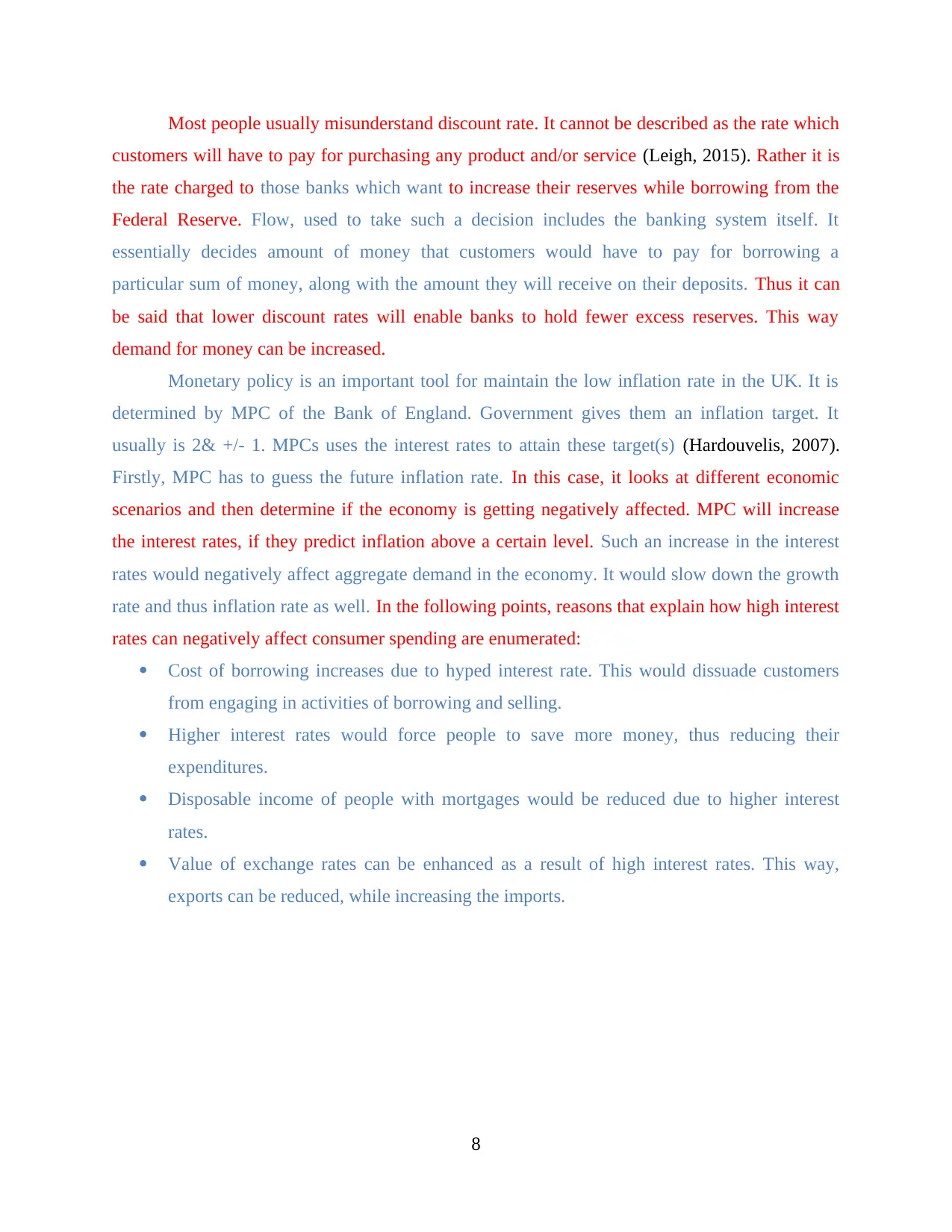
Most people usually misunderstand discount rate. It cannot be described as the rate which
customers will have to pay for purchasing any product and/or service (Leigh, 2015). Rather it is
the rate charged to those banks which want to increase their reserves while borrowing from the
Federal Reserve. Flow, used to take such a decision includes the banking system itself. It
essentially decides amount of money that customers would have to pay for borrowing a
particular sum of money, along with the amount they will receive on their deposits. Thus it can
be said that lower discount rates will enable banks to hold fewer excess reserves. This way
demand for money can be increased.
Monetary policy is an important tool for maintain the low inflation rate in the UK. It is
determined by MPC of the Bank of England. Government gives them an inflation target. It
usually is 2& +/- 1. MPCs uses the interest rates to attain these target(s) (Hardouvelis, 2007).
Firstly, MPC has to guess the future inflation rate. In this case, it looks at different economic
scenarios and then determine if the economy is getting negatively affected. MPC will increase
the interest rates, if they predict inflation above a certain level. Such an increase in the interest
rates would negatively affect aggregate demand in the economy. It would slow down the growth
rate and thus inflation rate as well. In the following points, reasons that explain how high interest
rates can negatively affect consumer spending are enumerated:
Cost of borrowing increases due to hyped interest rate. This would dissuade customers
from engaging in activities of borrowing and selling.
Higher interest rates would force people to save more money, thus reducing their
expenditures.
Disposable income of people with mortgages would be reduced due to higher interest
rates.
Value of exchange rates can be enhanced as a result of high interest rates. This way,
exports can be reduced, while increasing the imports.
8
customers will have to pay for purchasing any product and/or service (Leigh, 2015). Rather it is
the rate charged to those banks which want to increase their reserves while borrowing from the
Federal Reserve. Flow, used to take such a decision includes the banking system itself. It
essentially decides amount of money that customers would have to pay for borrowing a
particular sum of money, along with the amount they will receive on their deposits. Thus it can
be said that lower discount rates will enable banks to hold fewer excess reserves. This way
demand for money can be increased.
Monetary policy is an important tool for maintain the low inflation rate in the UK. It is
determined by MPC of the Bank of England. Government gives them an inflation target. It
usually is 2& +/- 1. MPCs uses the interest rates to attain these target(s) (Hardouvelis, 2007).
Firstly, MPC has to guess the future inflation rate. In this case, it looks at different economic
scenarios and then determine if the economy is getting negatively affected. MPC will increase
the interest rates, if they predict inflation above a certain level. Such an increase in the interest
rates would negatively affect aggregate demand in the economy. It would slow down the growth
rate and thus inflation rate as well. In the following points, reasons that explain how high interest
rates can negatively affect consumer spending are enumerated:
Cost of borrowing increases due to hyped interest rate. This would dissuade customers
from engaging in activities of borrowing and selling.
Higher interest rates would force people to save more money, thus reducing their
expenditures.
Disposable income of people with mortgages would be reduced due to higher interest
rates.
Value of exchange rates can be enhanced as a result of high interest rates. This way,
exports can be reduced, while increasing the imports.
8
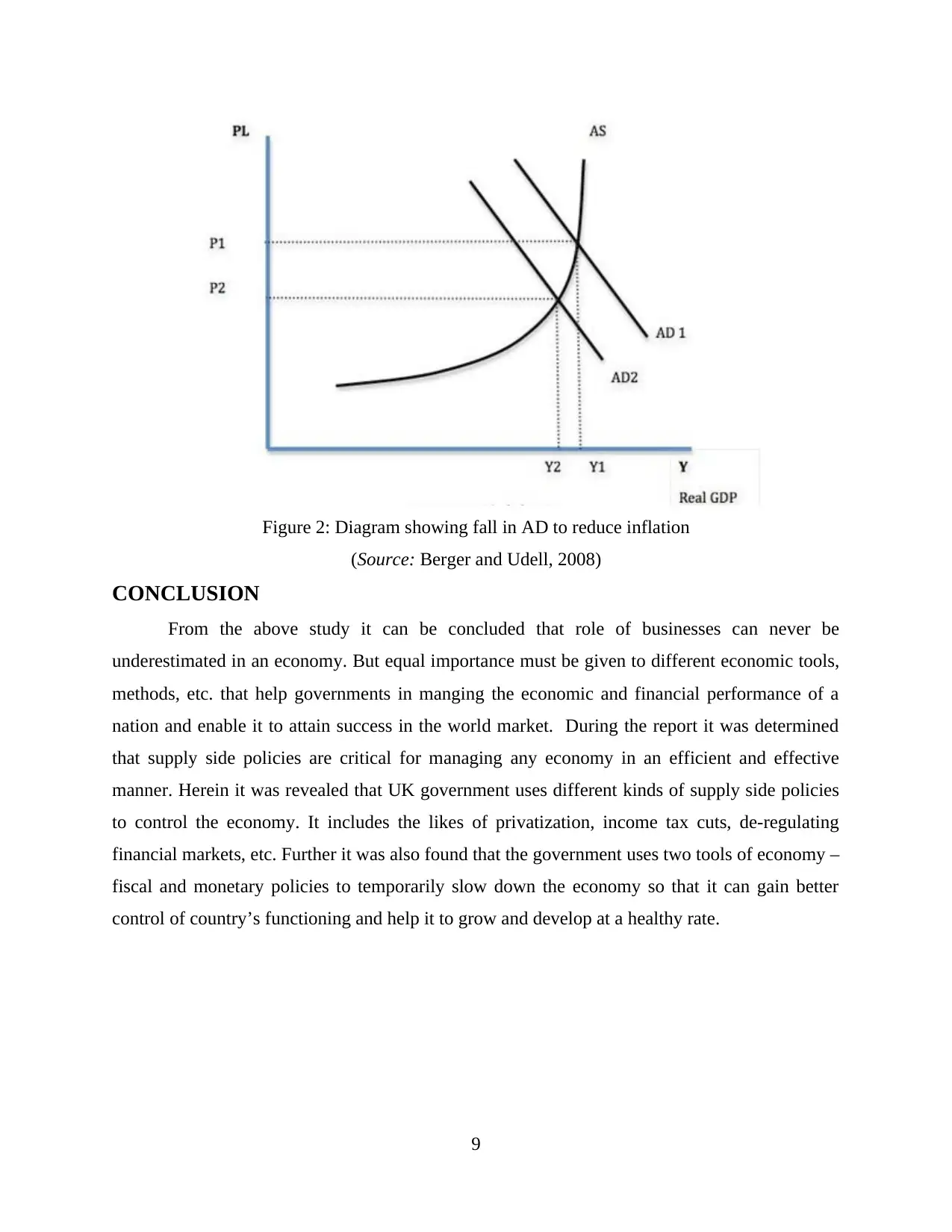
Figure 2: Diagram showing fall in AD to reduce inflation
(Source: Berger and Udell, 2008)
CONCLUSION
From the above study it can be concluded that role of businesses can never be
underestimated in an economy. But equal importance must be given to different economic tools,
methods, etc. that help governments in manging the economic and financial performance of a
nation and enable it to attain success in the world market. During the report it was determined
that supply side policies are critical for managing any economy in an efficient and effective
manner. Herein it was revealed that UK government uses different kinds of supply side policies
to control the economy. It includes the likes of privatization, income tax cuts, de-regulating
financial markets, etc. Further it was also found that the government uses two tools of economy –
fiscal and monetary policies to temporarily slow down the economy so that it can gain better
control of country’s functioning and help it to grow and develop at a healthy rate.
9
(Source: Berger and Udell, 2008)
CONCLUSION
From the above study it can be concluded that role of businesses can never be
underestimated in an economy. But equal importance must be given to different economic tools,
methods, etc. that help governments in manging the economic and financial performance of a
nation and enable it to attain success in the world market. During the report it was determined
that supply side policies are critical for managing any economy in an efficient and effective
manner. Herein it was revealed that UK government uses different kinds of supply side policies
to control the economy. It includes the likes of privatization, income tax cuts, de-regulating
financial markets, etc. Further it was also found that the government uses two tools of economy –
fiscal and monetary policies to temporarily slow down the economy so that it can gain better
control of country’s functioning and help it to grow and develop at a healthy rate.
9
⊘ This is a preview!⊘
Do you want full access?
Subscribe today to unlock all pages.

Trusted by 1+ million students worldwide
1 out of 14
Related Documents
Your All-in-One AI-Powered Toolkit for Academic Success.
+13062052269
info@desklib.com
Available 24*7 on WhatsApp / Email
![[object Object]](/_next/static/media/star-bottom.7253800d.svg)
Unlock your academic potential
Copyright © 2020–2025 A2Z Services. All Rights Reserved. Developed and managed by ZUCOL.




